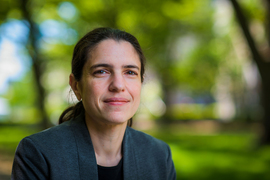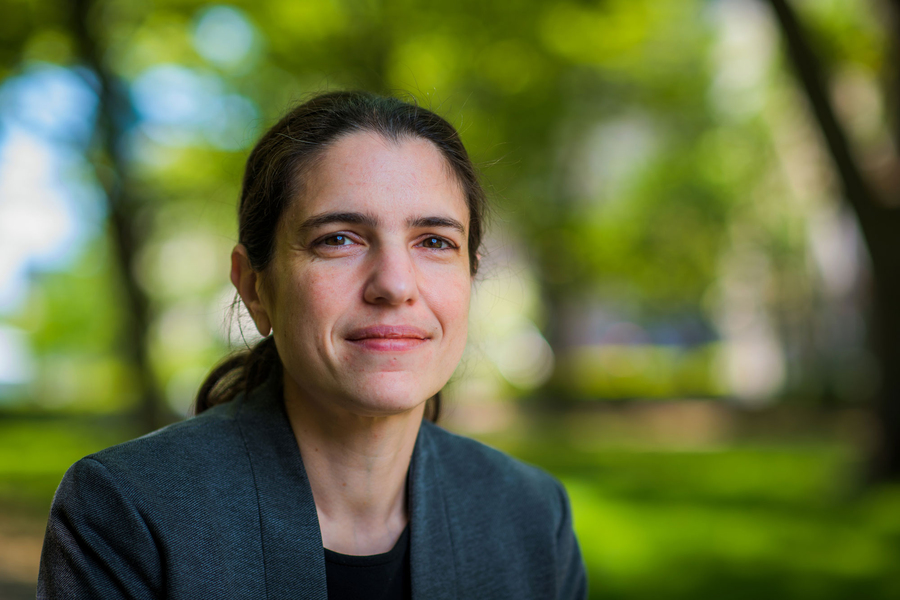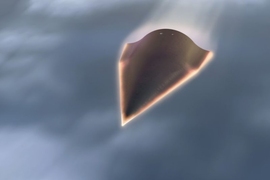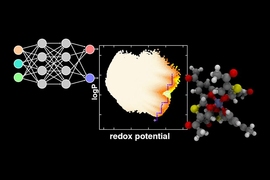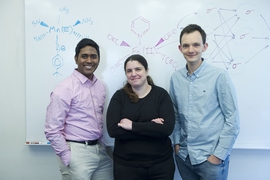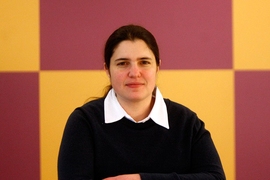The direct conversion of methane gas to liquid methanol at the site where it is extracted from the Earth holds enormous potential for addressing a number of significant environmental problems. Developing a catalyst for that conversion has been a critical focus for Associate Professor Heather Kulik and the lab she directs at MIT.
As important as that research is, however, it is just one example of the innumerable possibilities of Kulik’s work. Ultimately, her focus is far broader, the scope of her exploration infinitely more vast.
“All of our research is dedicated toward the same practical goal,” she says. “Namely, we aim to be able to predict and understand using computational tools why catalysts or materials behave the way they do so that we can overcome limitations in present understanding or existing materials.”
Simply put, Kulik wants to apply novel simulation and machine-learning technologies she and her lab have developed to rapidly investigate the sprawling world of possible chemical combinations. In the process, the team is mapping out how chemical structures relate to chemical properties, in order to create new materials tailored to particular applications.
“Once you realize the sheer scale of how many materials we could or should be studying to solve outstanding problems, you realize the only way to make a dent is to do things at a larger and faster scale that has ever been done before,” Kulik says. “Thanks to both machine-learning models and heterogeneous computing that has accelerated first-principles modeling, we are now able to start asking and answering questions that we could never have addressed before.”
Despite Kulik’s many awards and consistent recognition for her research, the New Jersey native was not always destined to be a scientist. Her parents were not particularly interested in math and science and, although she was mathematically precocious and did arithmetic as a toddler and college-level classes in middle school, she pursued other interests into her teens, including creative writing, graphic design, art, and photography.
Majoring in chemical engineering at the Cooper Union, Kulik says she wanted to occupy her mind, do something useful, and “make an okay living.” Chemical engineering was one of the highest-paying professions for undergraduates, she says.
The first thing she remembers hearing about graduate school was from a teaching assistant in her undergraduate physics class, who explained that being in academia meant “not having a real job until you’re at least 30” and working long hours.
“I thought that sounded like a terrible idea!” Kulik says.
Luckily, some of her classroom experiences at the Cooper union, as well as encouragement from her quantum mechanics professor, Robert Topper, led her toward research.
“While I wanted to be useful, I kept being drawn to these fundamental questions of how knowing where the atoms and electrons were located explained the world around us,” she says. “Ultimately, I obtained my PhD in computational materials science to become a scientist who works with electrons every day for that reason. Since what I do hardly ever feels like a chore, I now have a greater appreciation for the fact that this path allowed me to ‘not have a real job.’”
Kulik credits MIT professor of chemistry and biology Cathy Drennan, whom Kulik collaborated with during graduate school, with “helping me see past the short-term barriers that come up in academia” and “showing me what a career in science could look like.” She also mentions Nicola Marzari, her PhD advisor, then an associate professor in the MIT’s Department of Materials Science and Engineering, and her postdoc advisor at Stanford University, Todd Martinez, “who gave me a glimpse of what an independent career might look like.”
Kulik works hard to pass on her ethics and her ideas about work-life balance to students in her lab, and she teaches them to rely on each other, referring to the group as a “tight-knit community all with the same goals.” Twice a month, she holds meetings at which she encourages students to share how they have come up with solutions when working through research problems. “We can each see and learn from different problem-solving strategies others in the group have tried and help each other out along the way.”
She also encourages a light atmosphere. The lab’s web page says its members “embrace very #random (but probably fairly uncool) jokes in our Slack channels. We are computational researchers after all!”
“We like to keep it lighthearted,” Kulik says.
Nonetheless, Kulik and her lab have achieved major breakthroughs, including changing the approach to computational chemistry to make the way multiscale simulations are set up more systematic, while exponentially accelerating the process of materials discovery. Over the years, the lab has developed and honed an open-source code called molSimplify, which researchers can use to build and simulate new compounds. Combined with machine-learning models, the automated method enabled by the software has led to “structure-property maps” that explain why materials behave as they do, in a more comprehensive manner than was ever before possible.
For her efforts, Kulik has won grants from the MIT Energy Initiative, a Burroughs Wellcome Fund Career Award at the Scientific Interface, the American Chemical Society OpenEye Outstanding Junior Faculty Award, an Office of Naval Research Young Investigator Award, a DARPA Young Faculty Award and Director's Fellowship, the AAAS Marion Milligan Mason Award, the Physical Chemistry B Lectureship, and a CAREER award from the National Science Foundation, among others. This year, she was named a Sloan Research Fellow and was granted tenure.
When not hard at work on her next accomplishment, Kulik enjoys listening to music and taking walks around Cambridge and Boston, where she lives in the Beacon Hill neighborhood with her partner, who was a fellow graduate student at MIT.
Each year for the past three to four years, Kulik has spent at least two weeks on a wintertime vacation in a sunny climate.
“I reflect on what I’ve been doing at work as well as what my priorities might be both in life and in work in the upcoming year,” she says. “This helps to inform any decisions I make about how to prioritize my time and efforts each year and helps me to make sure I’ve put everything in perspective.”
